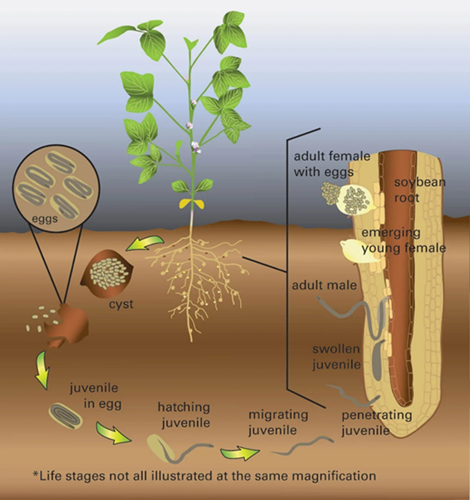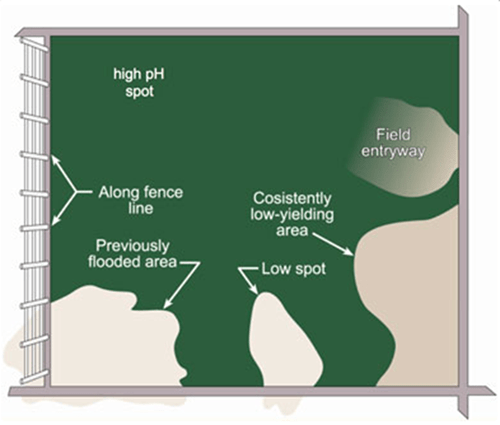Soybean Cyst Nematode Part 1; Understand the Pest, Scout, and Test
BY Dairyland Seed Agronomy Team
The vast majority of this information can be found be found on the Soybean Research Information Network https://soybeanresearchinfo.com/ and the SCN Coalition https://www.thescncoalition.com There will be a follow up article in next week’s Agronomy Newsletter: SCN Part 2; Interpreting Results, Management Considerations & HG types. Stay tuned….
In practically all soybean growing areas of the Dairyland Seed footprint some level of SCN pressure can be found. Do you know how much pressure you may have? Or, in other words, how many bushels you may be forfeiting? You often can’t tell. SCN is a thieving presence from only looking at the field. It is estimated that there may be up to 30% reductions in yields without noticeable above ground visual symptomology. Use the SCN Profit Checker to find estimations on your fields https://www.thescncoalition.com/profitchecker/calculator
Unfortunately, the SCN presence on our acres is nearly impossible to eliminate once acquired, but we can manage it to minimize SCN reproduction and maximize yields to the best of our ability by understanding the pest, scouting, and testing.
Understanding the pest is the first item. Nematodes are plant parasitic round worms that make up the second largest phylum in the animal kingdom encompassing up to half a million different species. The culprit of today’s discussion, Soybean Cyst Nematodes (SCN) has three major stages: egg, juvenile, and adult whose entire lifecycle can be completed in less than four weeks under ideal conditions with soil temps at or above 75⁰ F. The image below demonstrates the complete process and remember, expect multiple generations to visit your crop each year.

Diagram courtesy Iowa State University. https://soybeanresearchinfo.com/soybean-disease/soybean-cyst-nematode-scn/
Visible symptoms can include stunted plants, mid-season yellowing, and premature senescence. Below ground root symptoms can be difficult to determine unless they are compared to lesser infected specimens. These may include dwarfed or stunted root systems, reduced symbiotic nodulation, and increased susceptibility/symptomology to other soil-borne plant pathogens. Simply put, SCN feeding opens massive avenues for pathogenetic pressure from any opportunistic source early in the season such as PRR, BSR, SDS, fsarium, etc.
Testing for this pest is critical if you really want to help increase soybean yield potential on acres that might not perform to their full potential in your opinion. According to the North Central Soybean Research Program (NCRSP), fall is often the best time to sample as you plan for the next crop year and look for answers on your current crop. There are several states that offer free testing via their individual state Soybean Checkoff funds. In the in the Dairyland Seed footprint these include Michigan, Minnesota, South Dakota, and Wisconsin. The equipment needed for sampling soil for SCN is the same equipment you use for taking a soil sample for soil nutrient analysis: a soil probe, a bucket, and a plastic or plastic-lined soil bag.
- Probe the top 6 to 8 inches of soil.
- Take cores from within the root zone and within the interrow area. You'll want to take 10 to 20 cores in a 20-acre area. If the field is larger, break the field into 20-acre units and take 10 to 20 cores per unit.
- Should you be collecting soil samples on a 2.4- or 2.5-acre grid pattern, collect two extra cores from every 8 or 9 grid cells, and place those extra cores in a separate bag for SCN testing. The more cores you take, the better the estimate of SCN population density across the field. Pay particular attention to suspect or high-risk areas, such as those pictured below.

- Mix and pack soil samples by combining cores in a container. Take the time to thoroughly mix all the cores within the sample. The better the sample is mixed the better it represents the whole field. Put 1 to 2 pints of the thoroughly mixed soil in a plastic bag and label it with an indelible marker. Don't put a paper label inside the bag. The moist soil will make it unreadable by the time the sample reaches the lab.
- The sample doesn't really require any special handling. You'll want to keep the sample at room or field temperature. Keep the sample out of the sun or hot truck cab until you are ready to pack and ship it. Pack the samples in a box for shipment to a qualified soil lab. Cushion the samples with packing material so the bags don't break open during shipping.
- Send to the appropriate University, Extension, or private testing lab for SCN plant diagnostic clinics or University nematologists usually offer SCN testing. Check herefor contact information for the diagnostic clinic in your state.
Some private labs also offer SCN testing, but not all soil fertility labs are trained to test for SCN. Make sure your lab can test for SCN before shipping the sample.
Include your name, address, and phone number with your sample. Including cropping history of the field, symptoms of problems observed and cropping plans for the next season are helpful in making recommendations for management if SCN is confirmed. Often there is an Information Request Form that can be printed out from the clinic web site.

Brian Weller
Western Region
507.456.3034

Rod Moran
Western Region
507.456.3034

Dan Ritter
Central Region
219.863.0583

Branden Furseth
Northern Region
608.513.4265

Mark Gibson
Eastern Region
260.330.8968

Amanda Goffnett
Eastern Region
989.400.3793

Ryan Mueller
Eastern Region
989.400.3793
